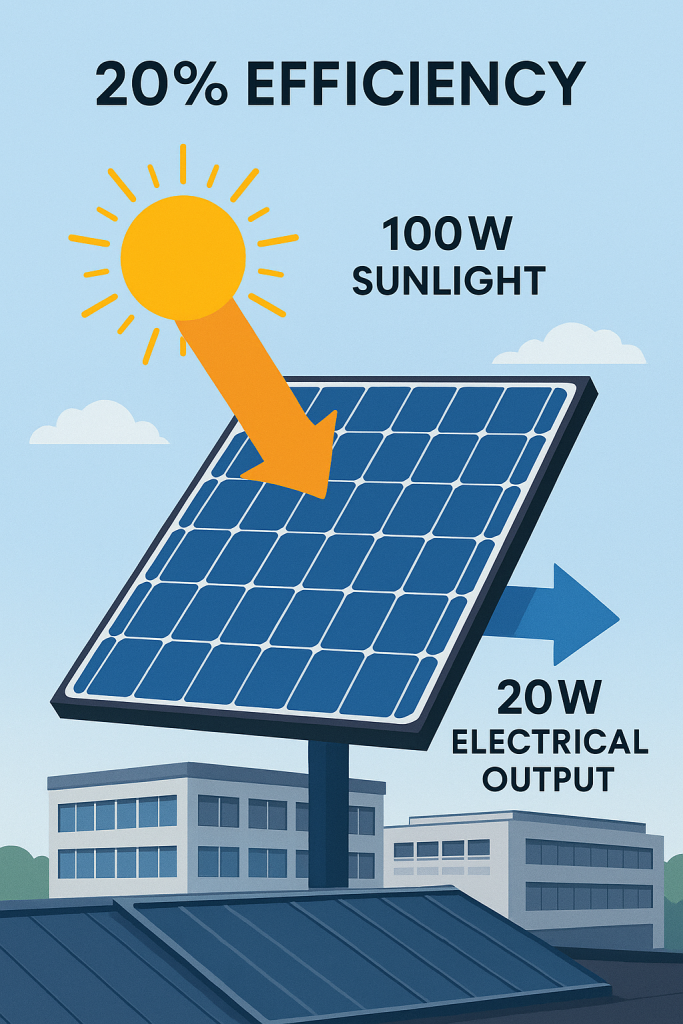What Does 20% Efficiency Mean for Solar Panels?
20% solar panel efficiency means the panel converts 20% of incoming sunlight into electricity. For every 100 watts of solar energy, the panel produces 20 watts of usable power. This metric, known as conversion efficiency, reflects how well a photovoltaic module utilises available sunlight under standard test conditions.
A higher efficiency rating indicates better performance in limited space. This factor matters significantly in commercial solar projects, where roof space or available land may be constrained. Commercial decision-makers must understand efficiency to evaluate system yield, investment value, and long-term performance.

Why Efficiency Matters for Commercial Solar
Solar panel efficiency determines the power output per square metre. Higher efficiency panels generate more energy in the same area, which benefits commercial premises with limited installation space or high energy demands.
Businesses investing in solar must consider:
- Roof space constraints: High-efficiency panels allow greater system capacity in smaller areas.
- Energy cost savings: More efficient panels yield higher returns through increased electricity generation.
- Installation cost structure: Fewer panels reduce mounting, wiring, and labour requirements.
- Payback period: Higher efficiency accelerates return on investment through improved yield.
Efficiency drives total output and directly impacts the system’s economic and operational value. For commercial applications, power density translates into better spatial optimisation and long-term savings.
Typical Efficiency Ranges by Solar Cell Type
Different solar cell technologies offer varying levels of efficiency. Commercial buyers should assess which type meets performance and budget criteria.
- Monocrystalline panels: ~18–22% efficiency. These use single-crystal silicon for superior performance and compact design.
- Polycrystalline panels: ~15–17% efficiency. Made from multi-crystal silicon, they provide lower efficiency at a reduced cost.
- Thin-film panels: ~10–12% efficiency. Lightweight and flexible, but significantly less efficient, suitable for niche commercial applications.
Panel type affects not just efficiency but also cost, aesthetics, and durability. For a full breakdown, refer to our Solar Cell Types guide.
Real World Factors That Affect Efficiency
Laboratory ratings assume controlled conditions. Real-world commercial sites introduce variables that reduce performance. Decision-makers must account for these in system design.
- Shading: Obstructions reduce output across entire arrays.
- Temperature: High heat decreases voltage; output drops ~0.5% per °C above 25°C.
- Orientation and tilt: Suboptimal angles reduce sunlight capture.
- Soiling: Dirt and debris block sunlight, reducing efficiency.
- Degradation: Output naturally declines ~0.5–1% per year.
Efficient system planning includes mitigating these losses through optimal layout, high-quality materials, and ongoing maintenance.
20% Efficiency in Perspective
A 20% efficient solar panel represents the upper range of performance in today’s market. For commercial installations, this level of efficiency supports better space utilisation, higher energy output, and stronger financial returns.
While efficiency should not be the sole criterion, it plays a key role in system performance when space, budget, and energy goals intersect. Understanding how efficiency interacts with cost and deployment conditions enables smarter solar investment decisions for UK businesses.

